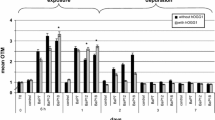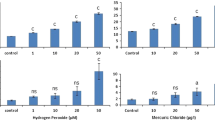Abstract
Anoxia-induced DNA damage in the gill cells of the marine scallop Mizuhopecten yessoensis was assessed with the alkaline comet assay (single-cell gel electrophoresis). The alkaline comet assay method for detecting DNA strand breaks and alkali labile sites in individual cells. DNA damage was determened in the scallops (M. yessoensis) gill cells. The scallops were exposed to air for 8 h showing a clear increase in the levels of DNA damage. After the air exposure, M. yessoensis were re-submersed for a period of 12 h, leading values to return to a pre-aerial exposure level. Control animals were kept immersed during the whole period. The resulting data demonstrate that natural influences, such as oxygen depletion (anoxia) in seawater, can be responsible for the induction of DNA damage. If the scallops were re-immersed in oxic conditions, the anoxically induced breaks were repaired. The main mechanisms influencing the integrity of the DNA structure are discussed in this paper.
Similar content being viewed by others
References
Almeida EA, Baini ACD, Dafre AL, Gomes OF, Medeiros MHG, Di Mascio P (2005) Oxidative stress in digestive gland and gill of the brown mussel (Perna perna) exposed to air and resubmersed. J Exp Mar Biol Ecol 318:21–30
Chandel NS, Shumacker PT (2000) Cellular oxygen sensing by mitochondria: Old questions, new insight. J Appl Physiol 88: 1880–1889
Chen MY, Yang HS, Delaporte M, Zhao SJ, Xing K (2007) Immune responses of the scallop Chlamys farreri after air exposure to different temperatures. J Exp Mar Biol Ecol 345:52–60
De Zwaan A (1977) Anaerobic energy metabolism in bivalve molluscs. Oceanogr Mar Biol 15:103–187
De Zwaan A, Eertman RHM (1996) Anoxic or aerial survival of bivalves and other euryoxic invertebrates as a useful response to environmental stress — a comprehensive review. Comp Biochem Physiol C 113:299–312
Dirmeier R, O’Brien KM, Engle M, Dodd A, Spears E, Poyton RO (2002) Exposure of yeast cells to anoxia induces transient oxidative stress. J Biol Chem 277:34773–34784
Donlon T, Norman A (1971) Kinetics of rejoining of single-strand breaks induced by ionizing radiation in DNA of human lymphocytes. Mutat Res 13:97–107
Enomoto T, Nakao C, Ohyama H (2000) Regulation of glycolysis during acclimation of scallops (Patinopecten yessoensis) to anaerobiosis. Comp Biochem Physiol B 127:45–52
Gorokhova E, Lof M, Halldorsson HP, Tjarnlund U, Lindstrom M, Elfwing T, Sundelin B (2010) Single and combined effects of hypoxia and contaminated sediments on the amphipod Monoporeira affinis in laboratory toxicity bioassays based on multiple biomarkers. Aquat Toxicol 99:263–274
Gray JS, Or YY (2002) Effects of hypoxia and organic enrichment on the coastal marine environment. Mar Ecol Prog Ser 238: 249–279
Istomina A, Dovzhenko N, Belcheva NN, Chelomin VP (2011) The activities of antioxidant enzymes in different molluscs during anoxia/hypoxia. Proc Samara Sci Center RAS 13:1106–1108 (in Russian)
Istomina A, Dovzhenko N, Chelomin VP (2011a) Antioxidant defenses during anoxia and recovery in marine bivalve Scapharca broughtoni. Proc Moscow Reg Univ 4:39–43 (in Russian)
Liepelt A, Karbe L, Westendorf J (1995) Induction of DNA strand breaks in rainbow trout Oncorhynchus mykiss under hypoxic and hyperoxic conditions. Aquat. Toxicol. 33:177–181
McLennan AG (2009) Ametabolic embryos of Artemia franciscana accumulate DNA damage during prolonged anoxia. J Exp Biol 212:785–789
Modig HG, Edgren M, Revesz L (1974) Dual effect of oxygen on the induction and repair of single-strand breaks in the DNA of X-irradiated mammalian cells. Int J Radiat Biol 26:341–353
Negreiros LA, Silva BF, Paulino MG, Fernandes MN, Chippari-Gomes AR (2011) Effects of hypoxia and petroleum on the genotoxic and morphological parameters of Hippocampus reidi. Comp Biochem Physiol C 153:408–414
Pannunzio TM, Storey KB (1998) Antioxidant defenses and lipid peroxidation during anoxia stress and aerobic recovery in the marine gastropod Littorina littorea. J Exp Mar Biol Ecol 221: 277–292
Romero MC, Ansaldo M, Lovrich GA (2007) Effect of aerial exposure on the antioxidant status in the subantarctic stone crab Paralomis granulose (Decapoda: Anomura). Comp Biochem Physiol C 146:54–59
Slobodskova VV, Solodova EE, Chelomin VP (2010) DNA damage (Comet Assay) as biomarker of Cd exposure in marine seed scallops Mizuhopecten yessoensis age 1 year. J Environ Sci Eng 4:63–69
Storey KB, Storey JM (1990) Facultative metabolic rate depression: Molecular regulation and biochemical adaptation in anaerobiosis, hibernation and estivation. Q Rev Biol 65:145–174
Wilson JT, Pascoe PL, Parry JM, Dixon DR (1998) Evaluation of the comet assay as a method for the detection of DNA damage in the cells of a marine invertebrates, Mytilus edulis L. (Mollusca: Pelecypoda). Mutat Res 399:87–95
Wu RSS (2002) Hypoxia: From molecular responses to ecosystem responses. Mar Pollut Bull 45:35–45
Author information
Authors and Affiliations
Corresponding author
Rights and permissions
About this article
Cite this article
Slobodskova, V.V., Zhukovskaya, A.F. & Chelomin, V.P. DNA damage in the gill cells of the marine scallop Mizuhopecten yessoensis during anoxic stress and aerobic recovery. Ocean Sci. J. 47, 95–100 (2012). https://doi.org/10.1007/s12601-012-0010-x
Received:
Revised:
Accepted:
Published:
Issue Date:
DOI: https://doi.org/10.1007/s12601-012-0010-x




